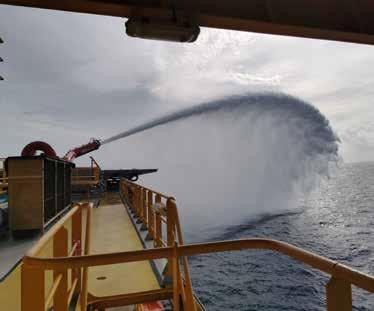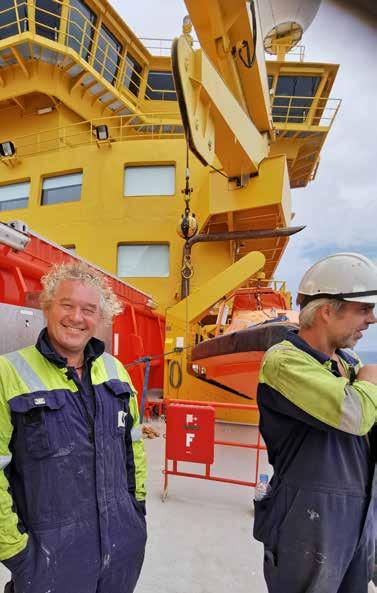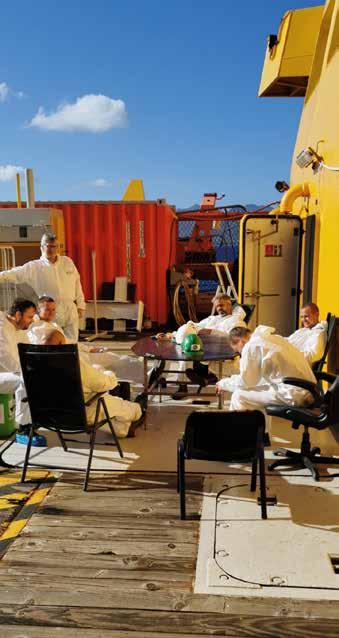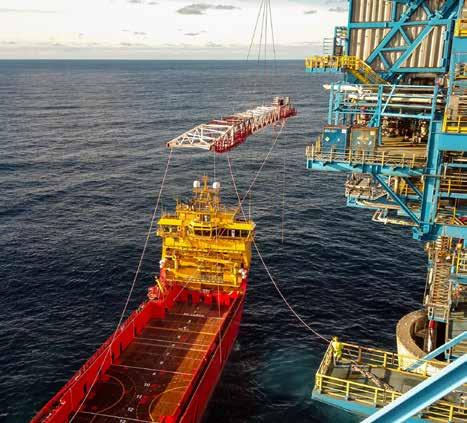
9 minute read
Slow ahead to home waters
Close but no cigar. The crew on Edda Fides could see land but were not allowed a crew change.
The flotel Edda Fides is back in home waters after finishing its assignments in Malaysia. The months-long sail back from Asia proved unusually demanding, owing to closed ports due to the Corona pandemic.
Advertisement
Inge Hansen Brekke (54) captained the first part of the journey. He entered Edda Fides for the first time in November last year, shortly after the last assignment was finished in Malaysian sector, and while the company worked intensely to secure new contracts. Weeks went by with no new assignments forthcoming. After a spell back home at Karmøy, Brekke was back on board in February, shortly before the company decided to return the hotel ship back to Europe, while still working hard in the market.
FIVE KNOTS
In Labuan, Malaysia, the hull was cleaned by divers, and the vessel and its crew of 17 prepared for departure. In early March, they weighed anchor and set course west and north. - We weren’t in a hurry. We planned the voyage for optimal fuel consumption, using mostly just one engine and maintaining a speed of five knots until we rounded South Africa, says Brekke. The first leg of the voyage went to Singapore, where they had planned a change of crew. - It couldn’t be done. The corona pandemic had reached Singapore. But we loaded provisions and bunkered up before sailing to Port Dickson in the Strait of Malacca. There we were allowed, barely, to change the Norwegian part of our crew. We arrived shortly before they closed down completely. We anchored up outside the harbour, and things went relatively smoothly. - They were not allowed onshore and had to stay on board all the way to Norway.
SOUTH AFRICA CLOSED
They reached Mauritius in four weeks. Another crew change was planned here, and Brekke himself was to step ashore. Underway, however, they received indications that this might prove difficult, and as they approached the archipelago, their fears were confirmed. Sailing into the harbour, they found it closed, along with - And what about the Philippine part of the crew?
the rest of the island. Again, they managed to secure provisions. - At that point, we were on high alert with regards to contagion. We wore full protective equipment and thoroughly disinfected every piece of provision brought on board, even placing it in quarantine. We accepted no risk, he says. - But back at sea, how was life on board sailing at five knots? - We made the most of it, and the spirits on board were high. We arranged barbecues on the pool deck, and were very social. Along the way we arranged line-crossing ceremonies. Six of the crew-members had never crossed the equator, and that occasion has to be celebrated. So naturally, King Neptune and his followers came aboard for the ceremony. The crew survived and had to walk the plank at the end, though thankfully, into the pool. It lifted our spirits. We also managed to complete a fair bit of maintenance on board.
- The next port of call was in South Africa? - We never reached it. We had a course for Durban, but was told it was impossible. Cape Town was the next possibility. A container was waiting for us there, sent from Norway to Singapore then Cape Town. The plan was to get it on board and change the crew again. On approach, however, we had to resign ourselves to the fact that it couldn’t be done. Not least because the airport was closed; no flights were coming in or going out. At the same time, the crew agreed that it was probably for the best not to go ashore here, given the Corona situation.
NEXT: THE CANARY ISLANDS
- We sailed on, while assessing possible ports of call along the African coast. At last we and the company agreed that the best thing to do was to set a course for the Canary Islands. We knew then that it could prove difficult getting flights home from here. Because of the circumstances, we’d have to face a very circuitous route home, having to stay at hotels in several «red» countries along the way. Naturally, we were overjoyed when a solution presented itself. Another shipping company were changing their crew in the Canaries, and had chartered a flight to Amsterdam. There was room on the flight for us. We were very happy with this solution, and with the company for making it happen for us. So we flew to Amsterdam and then directly to Oslo. It went without any issues, he says, having at that time been on board for 12 weeks.
CAPTAIN EINAR LINGA TAKES THE HELM
The 19th of May, Edda Fides arrived in Las Palmas in the Canary Islands, and a crew change could finally go through for the Norwegian crew. Captain Brekke went ashore, and Einar Linga took command as the ship continued northward. After a brief wait in the English Channel for a possible assignment that never materialised, the flotel set course straight for home, and Haugesund. - The weather was fair throughout the voyage. We felt safe, knowing the precautions taken back home. We didn’t feel too bad, says Brekke. - And now, after a deserved rest back with your family, you’re ready for work again. What is in store for you now? - I don’t know for sure. New orders are not yet coming in for Edda Fides, and I’m ready for other assignments in the meantime.
HAPPY ANYWHERE
Inge Hansen Brekke has sailed all categories of ships in the company’s portfolio. We ask him if there is any type of vessel he likes more than others. - For me, the work is the same. I had just as many interesting challenges in my time captaining the company’s tugs. There was a lot of sailing and activity on the supply ships as well, not to mention subsea. I’m very happy on these ships too, he says from his kitchen counter in Avaldsnes, ready for new assignments. When this magazine goes out, he’ll be standing on the bridge on one of the company’s ships in Norwegian or European waters, hopefully able to avoid any more seriously prolonged assignments. These days, though, that is practically impossible to predict.
Monthly maintenance routines.


Taking stores in Mauritius. All items taken on board is cleaned and "quarantined"

FACTS EDDA FIDES:
Edda Fides is an offshore Accommodation Service Vessel (ASV), since the company started taking orders in 2011, has had assignments in the North Sea, the Mediterranean, Australia, the Gulf of Mexico and lately, Malaysia.
The ship is 130 meters long with accommodation for 600 people in single and double cabins.
Edda Fides is a DP3 vessel, is equipped with a heave-compensated gangway which is lifted by an adjustable pedestal, making it possible to land the gangway from 13,5 to 32,5 meters.
SAKTE FART MOT HJEMLIGE FARVANN
Flotellet Edda Fides er igjen på hjemlige trakter etter å ha sluttført oppdrag i Malaysia. Seilasen hjem fra Asia tok mange måneder og ble en krevende reise på grunn av nedstengningen av havner i Corona-pandemiens kjølvann. Inge Hansen Brekke (54) var kaptein om bord på den første del av reisen. Etter et opphold hjemme på Karmøy, var Brekke om bord igjen i februar, rett før rederiet bestemte seg for å ta hotellskipet hjem til Europa mens markedsarbeidet fortsatt pågikk for fullt. I Labuan i Malaysia ble skroget rengjort ved hjelp av dykkere og fartøyet gjort klar for seilas. Det var et mannskap på 17 mann om bord. I begynnelsen av mars kastet de fortøyningene og satte kursen vest- og nordover. - Vi hadde ikke noe hastverk. Seilasen skulle skje så optimalt som mulig med tanke på forbruk av drivstoff. Vi brukte stort sett bare én motor og hadde en fart på omring fem knop helt til vi passerte Sør-Afrika, forteller skipper Brekke. Turen gikk først til Singapore, hvor det var planen å ha et første mannsskapsskifte. - Det fikk vi ikke til. Da hadde Corona-pandemien allerede slått til også her. Men vi tok om bord proviant og bunkers før vi dro til Port Dickson i Malakkastredet. Her fikk vi skifte den norske delen av mannskapet med nød og neppe. Vi var helt på grensen før nedstengingen kom. Vi lå til ankers utenfor havnen og det gikk kjapt og greit unna. - Det filippinske mannskapet kom seg ikke i land. De måtte være med på hele turen til Norge. De brukte fire uker fram til Mauritius, der det var planlagt et nytt mannskapsskifte. Der skulle også skipper Brekke ha gått av. Underveis fikk de imidlertid indikasjoner på at det kunne bli vanskelig, og det viste seg å stemme etter hvert som de nærmet seg øygruppen. Da de kom fram, var havnen og øya avstengt. Proviant klarte de imidlertid å få om bord. - Da var vi på «high alert» i forhold til smitte, ikledd fullt smittevernutstyr og gjennomførte full desinfeksjon av all proviant vi fikk om bord. Vi tok ingen sjanser, forteller han. - Neste planlagte stopp var Sør-Afrika? - Der kom vi aldri innom. Vi hadde kurs for Durban, men fikk kjapp melding om at det var umulig. Cape Town var neste mulighet. Der ventet også en container som opprinnelig var sendt fra Norge til Singapore, deretter ettersendt til Cape Town. Planen var å få den om bord og gjennomført nytt mannskapsskifte. Da vi nærmet oss, måtte vi resignert slå fast at også dette var umulig å gjennomføre, også fordi flyplassen var stengt. De seilte videre, vurderte andre alternativer langs Afrikakysten, men ble etter hvert enige med rederiet om at det beste ville være å sette kursen rett mot Kanariøyene.
Brekke og mannskapet visste at det også herfra kunne bli en utfordring å få dem videre hjemover med fly. De var derfor svært glade da det dukket opp en løsning. Et annet rederi skulle skifte mannskap på Kanariøyene og hadde leiet inn et charterfly til Amsterdam og der det var ledige plasser. Den 19. mai ankom Edda Fides Las Palmas på Kanariøyene og et skifte i norsk mannskap kunne endelig skje. Da gikk også skipper Brekke i land og Einar Linga overtok kommandoen da skipet fortsatte nordover. Det ble liggende i den engelske kanalen ei lita uke og avventet avklaring på et mulig oppdrag. Den kom ikke, hvorpå hotellskipet satte kursen hjem til Haugesund.
Hjemturen til Inge Hansen Brekke og avtroppende mannskap gikk smerte- og smittefritt. Da hadde han stått om bord i 12 uker.










